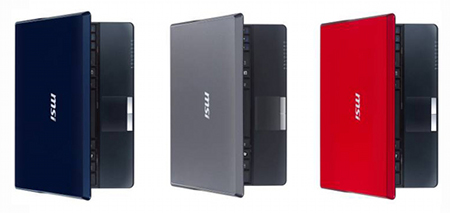N280 netbook has optional TV tuner
Apr 13, 2009 — by LinuxDevices Staff — from the LinuxDevices Archive — 9 views MSI has announced a netbook that uses Intel's 1.66GHz Atom N280 processor and offers an optional TV tuner. The “Wind U123” has a 10-inch display, 80GB, 120GB, or 160GB hard disk drives, “EasyFace” security software, and available HSDPA (high speed downlink packet access) networking, says MSI.
MSI has announced a netbook that uses Intel's 1.66GHz Atom N280 processor and offers an optional TV tuner. The “Wind U123” has a 10-inch display, 80GB, 120GB, or 160GB hard disk drives, “EasyFace” security software, and available HSDPA (high speed downlink packet access) networking, says MSI.
(Click here for a larger view of MSI's Wind U123)
 MSI's original Wind U100 (Click image to enlarge) |
MSI's new Wind U123 appears to be intended as a successor to the original, popular Wind U100 (right). The company highlights the device's “sharper lines and more stylish new colors,” compared to the “round and cute U100.”
The Wind U123 employs a 1.66GHz Intel Atom N280 instead of the 1.6GHz N270 used in the majority of other netbooks. Apparently, though, the main point of the CPU switch has merely been manufacturing economy or availability issues, since MSI has retained Intel's 945GSE (945GCSE northbridge and 82801GBM southbridge) supporting chipset. As a result, the U123 will not be able to support HD video, and is unlikely to perform noticeably better than the U100.

MSI's Wind U123 is initially available in blue, gray, and red
(Click to enlarge)
Compared to the U100, the U123 has a similar 10-inch display with 1024 x 600 resolution, but offers larger hard disk drives, available in 80GB, 120GB, and 160GB capacities. Shipped with 1GB of DDR2 RAM onboard, the netbook is expandable to 2GB, MSI says. The device also includes the typical webcam (available in 1.3 or 2 megapixel versions), 802.11b/g/n wireless networking, four-in-one (SD/MMC/XD/Memory Stick) card reader, and optional Bluetooth 2.0.
In a “U123H” variant, likely to be popular with carriers, MSI offers an integral HSDPA cellular modem, while a “U123T” version includes an integrated TV tuner that allows viewing and recording TV programs. All models include three USB 2.0 ports, except on the U123T, where the tuner displaces one of the ports.
Finally, MSI touts its “EasyFace” security software, which is said to operate in conjunction with the netbook's webcam. When a user is away from the netbook for a preselected length of time, the device locks itself automatically, and will only become operable again for someone whose eyes, cheekbones, jaw line and nose measure up to previously stored parameters, the company says.
Features and specifications provided by MSI for the Wind U123 include the following:
- Processor — Intel Atom N280 clocked at 1.66GHz
- Memory — 1 SODIMM socket for up to 2GB of RAM
- Display — 10-inch display with 1024 x 600 resolution
- Camera — 1.3 megapixel webcam
- Storage — 80GB, 120GB, or 160GB hard disk drive
- Networking — n/s, but may include 10/100 Ethernet port
- Wireless:
- 802.11b/g/n
- Bluetooth 2.0 (optional)
- HSDPA cellular modem (U123H only)
- TV tuner (U123T only)
- 802.11b/g/n
- Other I/O — 3 x USB 2.0, except U123T, which has 2 x USB 2.0
- Battery type — Three-cell or six-cell battery
- Dimensions — 10.23 x 7.08 x 1.29 inches (260 x 180 x 33mm)
- Weight — 2.2 pounds (1kg)
Background
For today at least, MSI is sitting out the ongoing controversy about what operating system netbooks ought to run. The U123 will almost be offered with Windows XP Home, and although MSI has backed away from Linux installs with its netbooks, it likely will Linux as well. However, no details of the device's operating system support have yet been released.
While the netbook marketplace has become considerably more competitive since the June 2008 introduction of MSI's Wind U100, that device scored impressive reviews. The British site TechRadar.com, for example, wrote, “It won't suit anyone looking for a powerhouse portable, but for basic needs, this is as good as it currently gets.” Here in the U.S., Laptop magazine wrote “this system's solid performance, stellar 5-plus hours of battery life, and $499 price make it the best all-around mini-notebook to date.”
Availability
MSI did not release information on pricing or availability for its Wind U123.
This article was originally published on LinuxDevices.com and has been donated to the open source community by QuinStreet Inc. Please visit LinuxToday.com for up-to-date news and articles about Linux and open source.